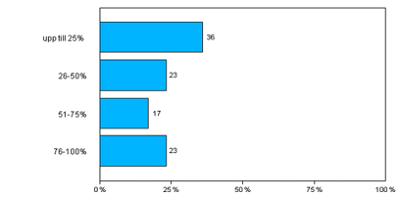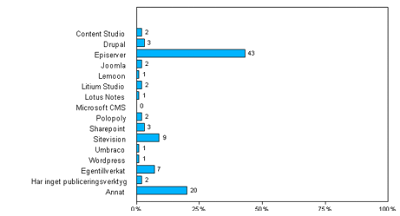The state of Swedish websites 2012
Each year Web Service Award surveys Swedish web responsibles and web managers their opinion about the quality of their web sites and working environment as well as how they are intending to develop them.

570 Swedish web managers were surveyed during January of this year for the 2012 trend report including representatives from companies, public services, councils, and other organisations.
The proportion of each type of organisation (and indeed size) is not representative of Sweden as a whole. Large companies and organisations are hugely over-represented (76% of those surveyed, whilst only 0.56% of the total in Sweden), and smaller companies are massively under-represented (24% of survey, but 76% in Sweden as a whole). So some care has to be taken with the figures.
This survey gives us an insight into what web managers think and how they feel about the world of web they work with. It’s not a survey of the visitors of websites, neither is it a survey of management or, ultimately, decision makers.
The report (in Swedish) is a whopping 98 pages. There’s a huge amount of data in there. I’m just going to write about a few points which I feel deserve highlighting.
The year of mobile development
Almost half of respondents said that they will be increasing their digital investments in 2012 compared to 2011. It would appear that a good chunk of that money is going to go into developing mobile solutions. 42% said that they are planning to produce a mobile ready version of their website, and 21% said they were planning a mobile app during 2012.

61% said that they didn’t currently have any form of mobile solution (neither app of mobile ready website), so if the web responsibles surveyed manage to achieve what they’ve planned then next year this figure should drop through the floor! 2012 is looking like the year of mobile development.
Lack of resources internally
Despite a constantly increasing amount of investment in digital channels, there hasn’t been a corresponding increase in internal resources that take care of them.
I find it quite shocking that despite the importance of websites for organisations, and the money invested in (re)developing them, a staggering 50% of respondents only work half-time with their sites. Only 23% at most are dedicated web managers working full time with their sites. Only 32% say that they have enough resources to manage their website’s content.

Given that almost half of the organisations surveyed are large organisations with over 500 employees (44%), the low number of dedicated web responsibles cannot be explained solely by a corresponding percentage of SME sites where it is would be more expected that a person has multiple roles.
With the time and knowledge needed to order from and work with external agencies, analyse and reflect upon visitor statistics and KPIs, take on board usability testing results, deciding what to A/B test and tweak on your website, chase content owners, meet and work with internal stake holders – amongst many other things – it’s no wonder that so many websites under deliver, or need to be (at often great cost) totally rebuilt every few years,
EpiServer dominates
Amongst the sites in the survey, EpiServer dominates overwhelmingly as the CMS of choice for the larger organisations (over 50 employees) with 50% using the Swedish platform to server up their websites.

It’s a different picture amongst the smaller organisations surveyed (less than 50 employees). Here we see EpiServer’s being used as the publishing tool for 22% of surveyed websites. 36% responded with “other”, which presumably includes an array of CMS tools created by smaller companies.
I’m surprised that WordPress didn’t feature higher amongst smaller companies. My experience is that it’s pretty much the default CMS choice for this size of company, but only 1% across the entire survey irrespective of organisation size (which is presumably just 5 respondents) said that WordPress powered their website.
Positive trends
Generally speaking most stats in the report point to positive developments with websites and how they are managed. One of the exceptions is the lack of (dedicated) resources to run, maintain and develop the web and digital presence of an organisation.
We’re learning and moving forward as web managers and web professionals, but It’s still early days, and I think many of the answers show that.
